Cambyses II › Late Period of Ancient Egypt » Ancient origins
Articles and Definitions › Contents
- Cambyses II › Who Was
- Late Period of Ancient Egypt › Antique Origins
Ancient civilizations › Historical and archaeological sites
Cambyses II › Who Was
Definition and Origins

Cambyses II (r. 530-522 BCE) was the second king of the Achaemenid Empire. The Greek historian Herodotus portrays Cambyses as a mad king who committed many acts of sacrilege during his stay in Egypt, including the slaying of the sacred Apis calf. This account, however, appears to have been derived mostly from Egyptian oral tradition and may therefore be biased. Most of the sacrileges attributed to Cambyses are not supported by contemporary sources. At the end of his reign, Cambyses faced a revolt by a man who claimed to be his brother Smerdis, and he died on his way to suppress this revolt.
KING OF BABYLON
Cambyses was born to Cyrus the Great and his wife Cassandane, a sister of the Persian nobleman Otanes. Cambyses had a younger brother named Smerdis, from the same mother and the same father. As early as 539 BCE, when Cyrus conquered Babylon, Cambyses held the position of crown prince. He is mentioned on the Cyrus Cylinder, along with his father Cyrus, as receiving blessings from the Babylonian supreme god Marduk. In Babylonian documents dating between April and December 538 BCE, Cambyses is described as 'king of Babylon', while Cyrus was given the title 'king of the lands'. Cambyses may have been appointed king of Babylon in preparation for his succession to the Persian throne.
CAMBYSES MAY HAVE BEEN APPOINTED KING OF BABYLON IN PREPARATION FOR HIS SUCCESSION TO THE PERSIAN THRONE.
Cambyses' reign as king of Babylon was inaugurated by his participation in the Babylonian New Year ceremony on 27 March 538 BCE. The most important function of the Babylonian New Year ceremony was to convey divine legitimization to the ruling monarch. The purpose of this ceremony was to convey divine legitimization to the ruling monarch. The event is described in the Nabonidus Chronicle, but due to the fragmentary nature of the text, it is hard to ascertain what happened. Cambyses is described as wearing Elamite clothing during the occasion and refusing to lay down his arms. This incident may have offended the Babylonian priesthood. It may also have been the reason why his reign as king of Babylon was cut short. After stepping down as king of Babylon, Cambyses remained active in the region, as his name appears in several legal documents from Babylon and Sippar.
EARLY REIGN
Shortly before departing on his campaign against the Massagetae, Cyrus named Cambyses both 'king of the lands' and 'king of Babylon'. When Cyrus died in December 530 BCE, Cambyses succeeded him without any trouble. The early years of Cambyses' reign were relatively uneventful, although a famine in Babylonia between 528 and 526 BCE may have led to rumours that the gods disapproved of the new king.
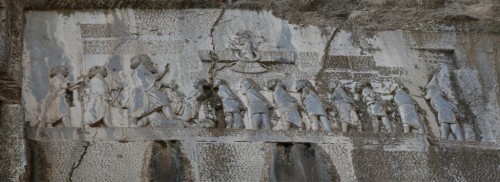
The Behistun Inscription
The Behistun Inscription of Darius the Great states that Cambyses killed his younger brother Smerdis during the early years of his reign:
Afterwards, Cambyses slew this Smerdis. When Cambyses slew Smerdis, it was not known unto the people that Smerdis was slain. Thereupon Cambyses went to Egypt.
The Greek historian Ctesias tells us that Cyrus had appointed Smerdis – known as 'Tanyoxarces' in the work of Ctesias – satrap of the eastern satrapies before his death, a position usually reserved for the crown prince. Since Cambyses had no heir, Smerdis was the next in line of succession. Cambyses may have feared his younger brother's strong position, killing him 'in secret' as the Behistun Inscription states.
CONQUEST OF EGYPT
In 525 BCE Cambyses invaded Egypt. Herodotus claims that Pharaoh Amasis II (aka Ahmose II, r. 570-526 BCE) had broken his promise to marry off his own daughter to Cambyses, sending the daughter of the former pharaoh Apries instead. This incident, however, appears to have been merely a pretext for Cambyses to subjugate the last remaining superpower of the region. Amasis himself died in November 526 BCE and was succeeded by his son Psamtik III (r. 526-525 BCE), but this did not stop Cambyses from invading Egypt. The campaign had likely been prepared years in advance.
On his way to Egypt, Cambyses marched his army along the Mediterranean coast. While passing through the Sinai desert, local Arabian chieftains supplied his army with fresh water. Cambyses also sent a Phoenician fleet with reinforcements along the Mediterranean coast. Psamtik sent his admiral Udjahorresnet (aka Wedjahor-Resne) to stop the Phoenician fleet, but Udjahorresnet apparently switched sides before any sea battle could take place. In a similar way, Polycratos of Samos, who had promised to provide Psamtik with mercenaries, decided to send these mercenaries to Cambyses instead. Psamtik was left without allies.
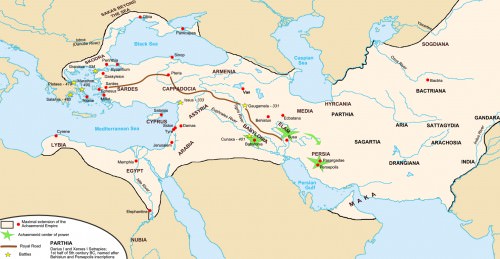
Achaemenid Empire Map
In May 525 BCE Cambyses reached the city of Pelusium, where the easternmost branch of the Nile Delta reaches the Mediterranean Sea. The Persian troops defeated the Egyptians in battle and went on to lay siege to Memphis. After the fall of Memphis, Cambyses continued to march along the Nile, and by August 525 BCE all of Egypt was in Persian hands. The neighbouring Libyan tribes and the Greek city-states along the Libyan coast voluntarily submitted to Cambyses. Upon his conquest of Egypt, Cambyses went to the Egyptian capital of Sais to have himself crowned pharaoh. He took on an Egyptian throne name and took part in Egyptian ceremonies, like his father Cyrus had done upon conquering Babylon. Admiral Udjahorresnet, who had crossed over to the Persians, was appointed chief physician and advisor to Cambyses.
Although Cambyses did not experience much trouble during his initial conquest of Egypt, the fact that he remained stationed there until 522 BCE indicates that he did face some resistance from the local population. At least one rival – Petubastis IV – challenged Cambyses' rule in 522 BCE. Petubastis likely had his residence in the Dakhla Oasis, deep in the Libyan desert.Cambyses may have sent an army to put down this revolt, and this army may have been defeated in battle. This defeat later gave rise to the legend of Cambyses' lost army, known from the work of Herodotus. In order to cover up this loss, the Persians claimed that Cambyses' army was lost in a sandstorm.
MADNESS
While contemporary sources depict Cambyses as a regular king who accommodated to the cultural and religious practices of the lands he conquered, Herodotus portrays him as a stereotypical mad king. Herodotus accuses Cambyses of defiling and burning the corpse of pharaoh Amasis and slaying a newborn Apis calf, who was worshipped as a god in Egyptian religion.In addition, Herodotus interprets Cambyses' murder of his brother Smerdis and his marriage to his sisters Roxane and Atossa as signs of his madness. Such stereotypical portrayals, however, usually arise from subjective oral traditions and should be treated with suspicion. Moreover, there are good reasons to doubt the specific claims pertaining to Cambyses' madness.

Apis Bull, Saqqara Serapeum
First of all, the notion that Cambyses slew a newborn Apis calf is contradicted by contemporary evidence. From funerary steles from the Serapeum of Saqqara, we may infer that one Apis bull died during Cambyses' reign, in September 524 BCE, but this bull was already twenty years old at the time. He was certainly not a newborn calf, as Herodotus claims, and the next Apis bull died during the reign of Darius the Great, at a mature age. Furthermore, the Egyptian priesthood may have had different reasons to hate Cambyses. Cambyses is known to have greatly curbed the privileges that had been bestowed upon the Egyptian temples by the pharaohs of the 26th Dynasty, so the story of Cambyses slaying the Apis bull may well have been invented to further damage Cambyses' reputation.
Another reason to suspect the account of Herodotus is that he places the murder of Smerdis after the invasion of Egypt and also after the slaying of the sacred Apis calf. The more or less contemporary Behistun Inscription, however, clearly states that Cambyses killed Smerdis before he went to Egypt. Herodotus, or his informer, may have taken a certain liberty in describing the order of events in order to make it appear like Cambyses' madness started after he slew the sacred Apis calf. The murder of Smerdis may indeed have been explained as a sign of madness by later Persian kings, but ultimately it was simply a strategic choice on Cambyses' part. Finally, we should not be surprised by Cambyses' marriage to his sisters Roxane and Atossa, as brother-sister marriages had been a common Elamite practice for centuries.
REVOLT OF (PSEUDO-) SMERDIS
In March 522 BCE, a man who claimed to be Cambyses' younger brother Smerdis started a rebellion in Persia. Since Cambyses had killed Smerdis 'in secret', most people knew no better than that Smerdis was still alive. The Behistun Inscription describes this event as follows:
Afterwards, there was a certain man, a Magian, Gaumâta by name, who raised a rebellion in Paišiyâuvâdâ, in a mountain called Arakadriš. On the fourteenth day of the month Viyaxana did he rebel. He lied to the people, saying: "I am Smerdis, the son of Cyrus, the brother of Cambyses."; Then were all the people in revolt, and from Cambyses they went over unto him, both Persia and Media, and the other provinces. He seized the kingdom; on the ninth day of the month Garmapada he seized the kingdom.
This narrative has been called into doubt by Albert T. Olmstead, who considers it unlikely that the murder of Smerdis went unnoticed for so many years and that a random imposter so easily took his place. Instead,
Olmstead believes that Cambyses never killed Smerdis and that the man who rose up against Cambyses in 522 BCE was, in fact, the real Smerdis. The 'imposter narrative' may have been invented by Cambyses to
delegitimize his brother's claim to the throne and was later adopted by Darius the Great to justify his coup against the legitimate successor of Cambyses.
Olmstead believes that Cambyses never killed Smerdis and that the man who rose up against Cambyses in 522 BCE was, in fact, the real Smerdis. The 'imposter narrative' may have been invented by Cambyses to
delegitimize his brother's claim to the throne and was later adopted by Darius the Great to justify his coup against the legitimate successor of Cambyses.
DEATH
Upon hearing about the revolt, Cambyses immediately gathered his army and prepared to march back home. He confessed to his army that he had killed the real Smerdis 'in secret' years before and claimed that the man
who now claimed to be Smerdis was, in fact, an imposter.
who now claimed to be Smerdis was, in fact, an imposter.
Cambyses never met Smerdis in battle. He died in April 522 BCE while he was on his way home. The Behistun Inscription states that Cambyses "died his own death" - a phrasing that has led to much speculation. Herodotus claims that Cambyses died in a Syrian town named Ecbatana after his sword slid out of his scabbard, piercing his thigh at the exact same place where he had stabbed the sacred Apis calf years before. This story seems to be derived from the same oral tradition that attributed Cambyses' madness to the slaying of the Apis bull and is therefore unreliable. Other interpretations are that Cambyses committed suicide or that he was assassinated.
Several places have been identified as Cambyses' tomb, including the Zendan-e Suleiman in Pasargadae and the Takht-e Rustam near Naqsh-e Rustam.
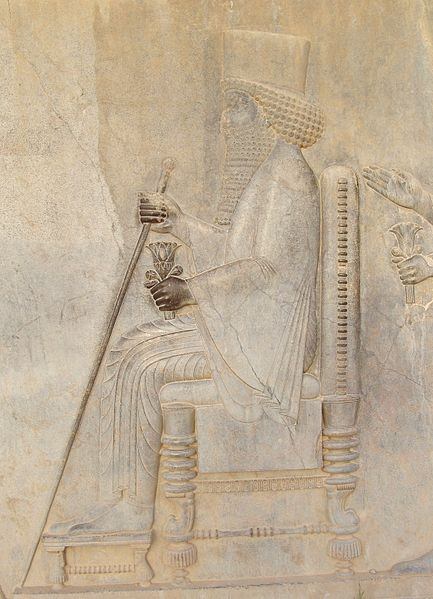
Relief of Darius I from Persepolis
LEGACY
Smerdis (either the real one or the imposter) continued to rule until September 522 BCE when he was assassinated by seven Persian noblemen. The ringleader of this conspiracy was Darius, who had been a lance-bearer to Cambyses. Now that all male descendants of Cyrus had died, Darius crowned himself king. He claimed to be a distant cousin of Cyrus and stated that the man who claimed to be Smerdis was an imposter. A civil war followed, in which Darius defeated all separatist leaders and reasserted his authority over the empire. With the rise of Darius, a different branch of the Achaemenid dynasty rose to power. Darius is known for consolidating the early Achaemenid conquests and reorganising the Achaemenid Empire.
As for Cambyses, his reputation quickly deteriorated after his death. The Persians remembered him mostly for his ignoble death, which to them was a sign that Cambyses had lost divine favour. Subsequently, all events from his reign were reinterpreted to fit this narrative. In addition, the Egyptians, who had come to resent Persian rule by the time when Herodotus was writing, had constructed a narrative of Cambyses being a mad king and a blasphemer. Looking at the contemporary evidence, however, Cambyses appears to have been a regular king who continued the policies of his father.
Late Period of Ancient Egypt › Antique Origins
Definition and Origins
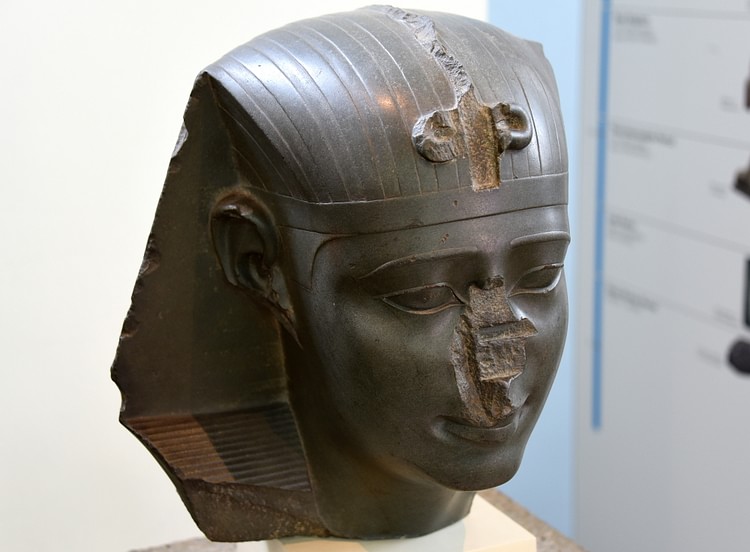
The Late Period of Egypt (525-332 BCE) is the era following the Third Intermediate Period (1069-525) and preceding the brief Hellenistic Period (332-323 BCE) when Egypt was ruled by the Argead officials installed by Alexander the Great prior to the rise of the Greek Ptolemaic Dynasty (323-30 BCE). This era is often ignored or sometimes combined with the Third Intermediate Period because, as with that period, it is interpreted as the final decline of Egyptian culture following the first Persian invasion of 525 BCE. While it is true that Persians ruled Egypt during the 27th and 31st dynasties, Egyptian culture was kept very much alive, and the 30th Dynasty of Egyptian rulers gave Egypt back a brief time of its former glory before the Persians came again.
This era comprises the 27th-31st dynasties of Egypt, but that designation is contested. Some scholars date the beginning of the Late Period to the middle of the 25th Dynasty or the beginning of the 26th for various reasons. Those who choose the mid-25th claim a distinct similarity between the social and political conditions of that time with the earlier Third Intermediate Period of Egypt, while those who cite the 26th Dynasty as beginning the Late Period point to Psammeticus I and his unification of Egypt following the Assyrian conquest. The Third Intermediate Period was a time of disunity lacking a central government, and so these scholars claim that Psammeticus I's reign ends that period and begins the next.
These claims, however, ignore the clear demarcation of the end of the 26th Dynasty with the first Persian invasion under Cambyses II (525-522 BCE) and the significant role the Persian rulers then played in Egyptian history until their empire was conquered and Egypt taken by Alexander the Great. Dating the beginning of the Late Period earlier than 525 BCE makes little sense when one considers the uniformity of other designations of Egyptian history. The names of these eras ( Predynastic Period in Egypt, Early Dynastic Period, Old Kingdom, First Intermediate Period, Middle Kingdom, etc.) were created by Egyptologists in the 19th and 20th centuries CE to help clarify the study of the country's long history and they were not chosen arbitrarily. There are clear reasons why one era of a strong central government (the 'kingdoms') is separated from a time of disunity ('intermediate periods'). In every case, a very clear political, social, and cultural entity prevailed which differed from that which preceded or followed. This same paradigm should be observed when considering the Late Period, and the only reason it is not is because the Third Intermediate Period is so often considered the epilogue to Egyptian history and the Late Period merely a sad extension of a long decline ending with Alexander's conquest of Persia.
THE LATE PERIOD WAS AN ERA OF GREAT ACHIEVEMENT & SAW A RENEWAL OF EGYPTIAN NATIONALISM & PRIDE IN THEIR ATTEMPTS TO THROW OFF PERSIAN RULE & REGAIN AUTONOMY.
Egyptian resistance to Persian rule, however, is evident throughout the period, and, further, Egypt prospered under Persian rule because the Persian Shahs admired the culture. Egyptian leaders like Amyrtaeus (404-398 BCE) of the 28th Dynasty, Nectanabo I (380-362 BCE), and Nectanabo II (360-343 BCE) all ruled the country, commanded their armies, and engaged in building projects in keeping with the great pharaohs of the past. Egyptian architecture of the Late Period purposefully recalled Egypt's great past, and as in the First Intermediate Period of Egypt, allowed for individual expression of the artist and the particular region instead of a state-mandated vision of a work. Although the Late Period cannot boast the number of monuments or buildings of Egypt's past, there are still some impressive works left behind and the pharaohs of the 30th Dynasty could hold their own in comparison to almost any dynasty of Egypt's past except perhaps the 4th, 12th, and 18th.
Art of the Late Period took inspiration from earlier eras such as the Old Kingdom and the Middle Kingdom of Egypt, but the artists were allowed freer expression. More realistic statuary was created and fine work was done in metals, gold, silver, and bronze. Mortuary rituals continued to be observed in more or less the same way they always had been, and the religious beliefs of Egypt were maintained. Even under Persian rule, there was no disruption in Egyptian religion - contrary to the claims made by Herodotus and other Greek writers - and the Persians, in fact, encouraged Egyptian culture and religion. Far from a dark period of oppression and decline, the Late Period was an era of great achievement and saw a renewal of Egyptian nationalism and pride in their attempts to throw off Persian rule and regain autonomy.
THE PERSIAN INVASION OF 525 BCE
According to Herodotus, Cambyses II of Persia invaded Egypt because of an insult by the Egyptian pharaoh Amassis of the 26th Dynasty. Cambyses wrote to Amassis asking for one of his daughters as a wife, but Amassis, not wishing to comply, sent the daughter of his predecessor Apries. The young woman was insulted by this decision - especially since it was tradition that Egyptian women were not given to foreign kings - and, when she arrived at Cambyses' court, she revealed her true identity.Cambyses accused Amassis of sending him a 'fake wife' and mobilized his troops to invade Egypt.
Whether this story is true, the Persian Empire would have eventually attacked Egypt anyway. The Assyrians had already conquered the country in the late 7th century BCE, and the Egyptian army had proven itself no match for the superior weapons and tactics of the Mesopotamian forces. The Persians, who were expanding their empire, would have known of the earlier conquest, known of Egyptian culture, and had little hesitation in launching an army of conquest. It was, in fact, Cambyses' knowledge of Egyptian culture that handed him the victory.
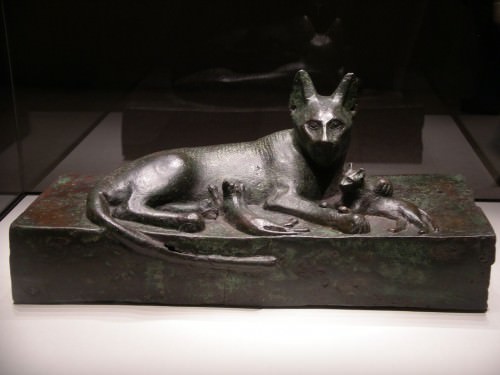
Egyptian Cat
The Persians struck at the entrance point of the city of Pelusium in 525 BCE and were repelled by forces under the pharaoh Psammeticus III. Cambyses, however, knew of the Egyptian's love for animals and, in particular, the cat and so had stray animals and cats rounded up, which he drove in front of his advancing army. He also had his soldiers paint the image of the Egyptian goddess Bastet, closely associated with cats, on their shields. Cambyses demanded the surrender of Pelusium and the Egyptians, not wishing to have the animals injured or incurring the wrath of Bastet, complied.
PERSIAN RULE OF EGYPT
Cambyses II is regularly depicted as a half-mad tyrant by Herodotus who claims he destroyed Egyptian temples, killed the sacred Apis bull, and led his troops on futile and destructive campaigns. The autobiography of the Egyptian admiral Wedjahor-Resne, who served under Cambyses, paints a very different picture. According to Wedjahor-Resne, Cambyses admired Egyptian culture and the admiral assisted his new king in proper observance of tradition and respect for religious sensibilities.He persuaded Cambyses to move a garrison of Persian soldiers away from the Temple of Neith in Sais, for example, because their presence was considered offensive to the goddess and instructed him in other areas as well.
Even though Cambyses seems to have accepted his admiral's counsel, Wedjahor-Resne also recounts the suffering of the Egyptians under Cambyses' reign. Many Egyptians were enslaved by upper-class Persians, and others were conscripted into the army. According to Herodotus, Cambyses sent an expedition toward Libya which was swallowed whole in a sandstorm.This event, often referred to in the modern day as the "Lost Army of Cambyses", is most likely one of Herodotus' fictions intended to show how paltry a king Cambyses was. The Greek writers, on the whole, tend toward highly unflattering portrayals of the Persian kings. The story has long been accepted as authentic history, however, and expeditions are still funded and launched to find the remains of the lost Persian army.
There is no doubt, though, that Cambyses launched a campaign against Nubia as he founded a trade center at the first cataract of the Nile, garrisoned with troops, which became an important point of cultural exchange between Egyptian, Nubian, and Persian merchants and soldiers. It seems Cambyses' goal was to conquer the wealthy Nubian city of Meroe, but having reached Nubia, he turned around and headed back for Egypt.
Herodotus reports that Cambyses died from an accidental self-inflicted wound to his thigh. Allegedly, the king pierced himself in the exact spot on his leg where he had stabbed and killed the Apis bull. This story is also considered fiction by most modern-day scholars as Herodotus enjoyed making moral points in his histories and the theme of the god avenging himself on a presumptive mortal appears a number of times in his works. This is not to say that Cambyses was a model pharaoh or kind ruler, only that he was perhaps not the lunatic Herodotus portrays him as.
Cambyses died in 522 BCE, probably en route to put down a rebellion back home. A pretender to the throne claimed to be Cambyses' brother Smerdis, which was actually impossible as Cambyses had already secretly murdered Smerdis years before. The pretender, a Magian named Gaumata, was killed by a member of the court named Darius who then took the throne. He is best known as Darius I the Great (522-486 BCE) who launched the First Persian Invasion of Greece in 490 BCE, which was routed at the Battle of Marathon.
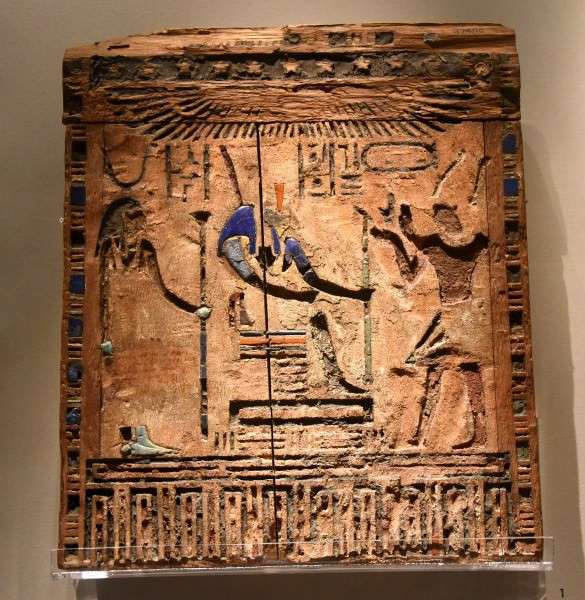
Darius I as Pharaoh of Egypt
Unlike Cambyses, Darius preferred to rule Egypt in absentia. He came to the throne of the Achaemenid Empire in 522 BCE and visited Egypt at least twice but preferred Egypt at a distance. Still, he also admired the culture and directed funds for the rebuilding of damaged temples and the dedication of new ones. In keeping with the Persian tradition of religious tolerance, Darius honored the gods of Egypt with gifts and monuments. He is generally regarded as affecting a gentler touch with Egypt than Cambyses had.
His son, Xerxes I (486-465 BCE), drew on all the resources of the Achaemenid Empire for the Second Persian Invasion of Greece in 480 BCE, and Egypt was no exception. The early part of Xerxes ' reign was almost wholly focused on avenging the insult of the Greeks at Marathon by subjugating the country completely. When the Persians were defeated at Salamis in 480 BCE and Plataea in 479 BCE, Xerxes lost interest in foreign affairs and concentrated on building projects and various affairs with women of the court. He was succeeded by Artaxerxes I (465-424 BCE) who struggled for six years to put down the first major Egyptian revolt, encouraged and aided by Athens, in 460-454 BCE.
This revolt was led by Inaros II (c. 460-454 BCE) the Libyan royal son of Psamtik (Psammeticus IV) of the old Saite Dynasty.Psamtik may have plotted a rebellion to regain control of Egypt but nothing came of it. Inaros II, with the help of the Athenians and allied with Amyrtaeus of Sais, almost succeeded in driving the Persians from the country but was finally defeated. He was brought in chains back to Susa where he was executed.
PERSIAN INVASIONS & THE 28TH/29TH DYNASTIES
His revolt inspired the grandson of Amyrtaeus of Sais, also known as Amyrtaeus, to revolt against the rule of Darius II (424-404 BCE) in 411 BCE. This Amyrtaeus is the founder and only king of the 28th Dynasty of Egypt and, although he is remembered as the Egyptian king who drove the Persians out of the country, he actually only controlled the Delta region of Lower Egypt. Upper Egypt remained in the hands of the Persians.
Darius II was succeeded by Artaxerxes II (404-358 BCE) who continued to hold Upper Egypt. Artaxerxes largely concerned himself with pitting Greek city-states against each other and ignored his Egyptian problem until 373 BCE when he sent an army to regain control but was defeated. While Artaxerxes was involved with the Greeks, Amyrtaeus had been killed in battle by a rival king from the city of Mendes named Nepherites I (c. 398-393 BCE) who took control of the Delta region and founded the 29th Dynasty.
The 29th Dynasty is one of the shortest in Egyptian history and, although it struggled to redeem the past and make Egypt a great power again, it never had the resources to succeed. Nepherites I, ruling from his capital at Mendes, engaged in a number of building projects in Lower Egypt but nothing as impressive as past pharaohs. He was succeeded by Psammuthes (c. 393-392 BCE) about whom little is known who was succeeded by Hakor (better known as Achoris, 392-379 BCE).
Hakor achieved what his predecessors had failed to accomplish in building projects and additions to the Temple of Amun at Karnak. In 385 BCE the Persians launched another invasion to recapture Egypt and, under Hakor's generals, were repulsed.Hakor then returned to his building projects and various negotiations with foreign powers. Upon his death, he was succeeded by his son Nepherites II (c. 380 BCE) who ruled for only four months until he was killed by the rival king Kheperkare Nakhtnebef, better known as Nectanebo I (c. 379-363 BCE) who founded the 30th Dynasty.
THE 30TH DYNASTY: LAST OF THE EGYPTIANS
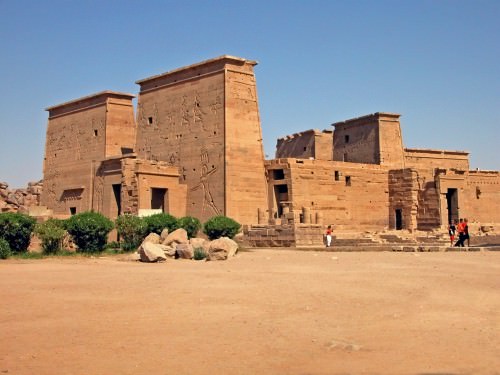
Philae Temple, Aswan
In all things, Nectanebo I comported himself as a great pharaoh of Egypt. He honored the gods with gifts, temples, obelisks, and other monuments; contributed to the development of Karnak; built up the Egyptian army; and formed alliances with various Greek city-states. C. 374 BCE the Persians again tried to retake Egypt, but Nectanebo I was prepared for them and heavily fortified Pelusium and the shores of the Nile near the city. This measure forced the Persian invasion into the more difficult branch of the river near the city of Mendes.
The Mendesian branch of the Nile was purposefully left unguarded to allow the Persian force easy access knowing that it would then take them longer to reach Memphis, their presumed goal. Although Memphis was no longer the capital of Egypt it remained an important religious and cultural center and its capture would have demoralized the Egyptians. The Persians were commanded by the Greek general Iphicrates and Persian commander Pharnabazus who each had different ideas on how to conduct the campaign. Their longer journey by way of the Mendesian branch of the Nile exacerbated the differences between them so that, once they finally arrived, they were in conflict. Nectanebo I had, meanwhile, fortified Memphis against them, and the Nile River itself cooperated at an opportune moment to flood the land; thus handing a total victory to Nectanebo I and sending the Persian forces back home.
Nectanebo I, again emulating the pharaohs of old, instituted the practice of co-regency with his son Djedhor in order to prevent problems of succession. Upon his death, Djedhor took the throne name Teos (362-360 BCE) and instantly began planning a campaign to punish the Persians. Nectanebo I had encouraged other regions to rebel against Persian rule and Teos believed the Persians were distracted enough by these rebellions that he could easily take their satrapy of Syria - Palestine for Egypt.
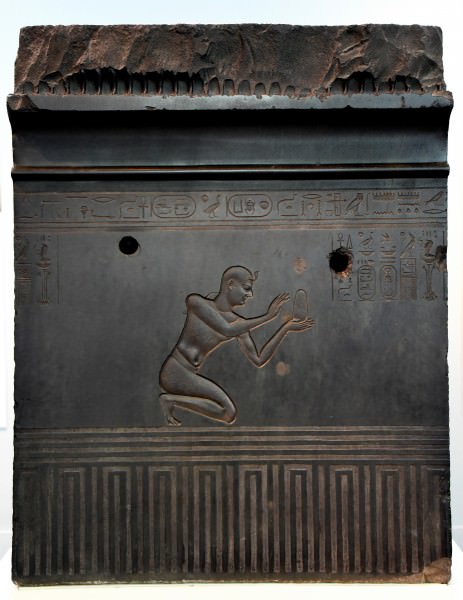
Screen Slab of King Nectanebo I
Teos allied himself with the Athenian general Chabrias and Spartan king Agesilaus II for this campaign but, requiring more money, raised taxes on the Egyptian people and, more significantly, on the priesthood and temples. These taxes were extremely unpopular, and the priesthood objected to the appropriation of their wealth for a military campaign which seemed unnecessary. Teos' brother, Tjahapimu, saw this dissent as an opportunity to raise his own son, Nakhthorheb, to power and encouraged him to betray Teos. Nakhthorheb complied eagerly; the campaign failed when Nakhthorheb drove a wedge between Teos and Agesilaus II, rallied the people to his cause, and proclaimed himself pharaoh, taking the name Nectanebo II (360-343 BCE). Teos fled for safety to his former enemies at Susa but was brought back to Egypt by command of Nectanebo II and, most likely, executed.
Nectanebo II, the last native of ancient Egypt to rule over the country, outdid Nectanebo I in building projects and shows of piety to the gods, commissioning work at over 100 sites during his reign. He maintained good relations with Sparta and employed Greek mercenaries in his army. Like his earlier predecessor, he strengthened the military, secured his borders, and improved the economy through trade. Given more time, and better circumstances, Nectanebo II could have been one of the greatest of Egyptian pharaohs, but he had neither time nor fortune on his side.
In 344 BCE Artaxerxes III (358-338 BCE) began courting allies and gathering a force to reclaim Egypt for Achaemenid Empire.The campaign was launched in 343 BCE and Nectanebo II, at the head of his army, was defeated. He fled south into Nubia and Artaxerxes III claimed Egypt for Persia. In time, Nectanebo II became a kind of legendary figure who, in the stories which eventually formed part of the Alexander Romance, was secretly the father of Alexander the Great. There is, of course, no historical basis for that claim.
PERSIAN EGYPT & ALEXANDER THE GREAT
Artaxerxes III was succeeded by Artaxerxes IV (338-336 BCE) who only controlled Lower Egypt. He was succeeded by Darius III (336-332 BCE) who conquered Upper Egypt, bringing the whole under Persian rule. Like the earlier Persian kings, Artaxerxes III, Artaxerxes IV, and Darius III encouraged Egypt's culture and traditions. This being so, Egyptian resistance may seem unwarranted. Historian Marc van de Mieroop comments on this:
Why did the Egyptians fight Persian rule so much? Many historians have written that these struggles were "nationalist movements" inspired by a dislike of the foreigner, xenophobia even...Several concerns probably inspired the revolts, but it is likely that the upper classes that had governed Egypt in the Third Intermediate and Late Periods instigated them. Deprived of their offices by the arrival of a Persian administration, some assimilated themselves into the Persian ranks but others were probably denied that opportunity. Many of them had Libyan ancestry and may have maintained close connections with that area. Some scholars even suggest that it was not Egyptians but people from the west who directed the revolts. They may have found support because the Persians imposed oppressive duties on Egyptians. (310)
It is clear that the revolts of the Late Period were either encouraged or openly supported by Greek city-states and, by this time, there was a sizeable population of Greeks living in Egypt at Naucratis. Naucratis was an important trade center for the Greeks and it is easy to imagine they were not pleased with having to deal with their old enemy Persia when they were used to dealing directly with Egyptians.
Whoever was behind the revolts against Persian rule, the second occupation of Egypt did not last long. Over in Europe, Philip II of Macedon (359-336 BCE) had conquered the Greek city-states and brought them under Macedonian rule. He was planning a grand campaign to conquer Persia when he was assassinated in 336 BCE. He already had in place all the resources he would need for the conquest and these were left to his son, Alexander.
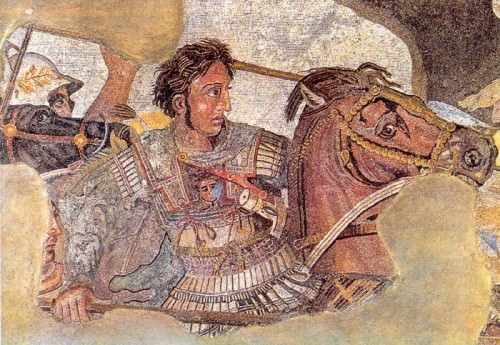
Alexander the Great
Alexander the Great embarked on his campaign in 334 BCE, defeated Darius III at the Battle of Issus in 333 BCE, took Syria in 332 BCE, and Egypt in 331 BCE. He founded the city of Alexandria at the old port city of Rhakotis on the Mediterranean Sea, drew up its plans, and left it for his administrators to develop. After being proclaimed a god at the Siwa Oasis, Alexander moved on to complete his conquest of Persia and left Egypt in the hands of the Macedonians who began construction of Alexandria and improvements to other cities in the Delta. When Alexander died in 323 BCE, Egypt was taken by his general Ptolemy I Soter (323-285 BCE) who founded the Ptolemaic Dynasty, the last to rule Egypt before the coming of Rome.
The Late Period marks the end of Egyptian rule of the country but hardly the end of Egyptian culture. The Persians, as noted, never tried to suppress Egyptian beliefs, and the 30th Dynasty encouraged a revival of past glories in art and architecture. The Ptolemies continued to observe the ancient rituals and traditions, and Egyptian culture was diffused throughout the ancient world through trade and the works of Greek, and later Roman, writers who admired it. The pharaohs of the 30th Dynasty, even the short-lived Teos, maintained the dignity of Egyptian kingship in keeping with the past and left their own impressive monuments in line with those who had come before them. The Late Period, then, may be regarded as the end of Egyptian autonomy but should not be regarded as the last gasp of Egyptian culture. Even to the present day, the cultural achievements of Egypt continue to inspire admiration, even awe, and remain among the most popular and fascinating of any in the ancient world.
LICENSE:
Article based on information obtained from these sources:with permission from the Website Ancient History Encyclopedia
Content is available under License Creative Commons: Attribution-NonCommercial-ShareAlike 3.0 Unported. CC-BY-NC-SA License